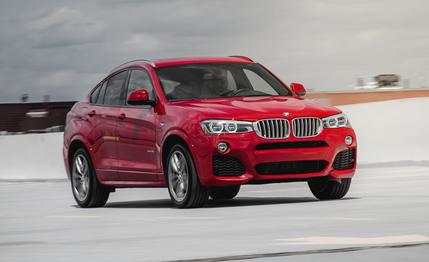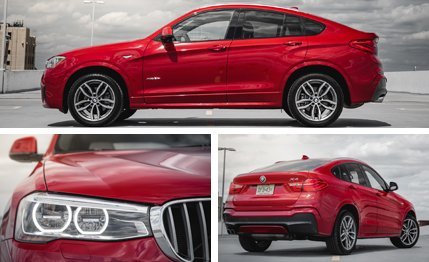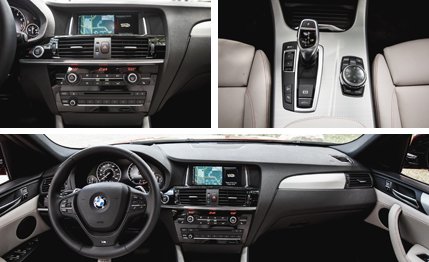
 Instrumented Test
Instrumented Test
Frivolity is the endgame of progress. It has to be. Computers are a great example. Once upon a time, they were magic. They allowed man to walk on the moon. They fueled an unprecedented boom in human knowledge and understanding. Today, much of the field’s public development centers on allowing people to play Candy Crush Saga while taking a dump.
Progress in the auto industry has similarly passed its apogee. We went from being able to buy a Ford, to being able to buy a Ford or a Hupmobile, to being able to buy bigger or smaller cars from our preferred brand, to choosing from bigger or smaller versions of a countless array of body styles from around the world, to now being able to buy less-practical versions of vehicles that, as it stood, nobody actually needed.
The relationship between the new chopped-top BMW X4 and its more useful X3 sibling is obvious. The X4 shares the X3’s wheelbase, its dashboard, and even its hood. Lopping 2.2 inches off the roofline doesn’t deprive front-seat passengers of much headroom, but costs those in the rear 1.7 inches of it. Taller occupants will care, but those nearer the middle of the human-factors bell curve won’t. In photos, it can be hard to tell whether you’re looking at an X4 or an X6, but you know how, in Smokey and the Bandit, Big Enos had that sort of charming Southern handsomeness but Little Enos was just ugly? No? Well, in the metal, BMW’s absurd “Sports Activity Coupe” proportions work better on the X6 than they do on its new Little Enos.


Powertrain choices are limited in the X4 compared with the X3. But buyers have already made their choice, and it is frivolity. There’s no rear-drive model, and while a diesel would have fit nicely with the X4 theme by virtue of costing more, its increased efficiency would have made it a more practical version of a less practical version of a car nobody needs, so BMW wisely chose not to confuse the issue any further. All-wheel drive is standard, as is an eight-speed automatic; drivetrain choice is limited to the four-cylinder X4 xDrive28i and the six-pot X4 xDrive35i.
If you’re going to be frivolous, you should at least be frisky, and so the X4 seen here is the six-cylinder. It starts at $48,950, while the four-cylinder begins at $45,650. With 300 horsepower, the turbo six slings the X4 to 60 mph in just 5.2 seconds and through the quarter-mile in 13.8 at 100 mph. The full-bodied, torquey feel and smooth soundtrack are as pleasing in the X4 as they are in any of the rest of BMW’s lineup. And the eight-speed automatic is as transparent as any transmission on the road today, allowing the X4 to attain alarming speeds with disarming ease.
Maintaining those alarming speeds through corners is made easy and fun, thanks to the uncharacteristic—for other SUVs, anyway—dynamic abilities the X4 shares with the rest of BMW’s utilities. It’s delightfully neutral, and the Dynamic Damper Control fitted to our example kept a tight rein over roll. The brake pedal is firm but has enough give to allow somewhat ham-footed driving without being herky-jerky. In other words, it’s perfect for an SUV.


But it takes a long time for that perfectly weighted left pedal to do its job. This X4’s 192-foot stop from 70 mph is two feet longer than the last Chevrolet Suburban we tested. We’ve logged disappointing stops from lots of BMW SUVs lately, but this one is the worst. Tires that are stickier than the Goodyear Eagle LS2 run-flats worn by this example would definitely make a difference, and they’d probably improve on its already-impressive 0.86-g skidpad performance. It strikes us as silly that we tested the M Sport package and still so badly wanted better tires. Higher-performance rubber in staggered 245 (front) and 275 (rear) widths is a no-cost option we wish we’d had. We’re interested to know what sort of improvement we might see from them.
We did have plenty of other extras on this X4. In addition to the $1900 M Sport package ($2900 with Dynamic Damper Control), we had the $700 Driver Assistance package (rearview camera and park-distance sensors), the $1900 Lighting pack (adaptive full-LED headlights), the $2200 Premium pack (passive entry, adjustable lumbar, and satellite radio), and the $3150 Technology package (nav with real-time traffic info and a head-up display). Standalone extras included $550 for the Melbourne Red paint, $500 for heated front seats, and $500 for the ability to connect a smartphone with Bluetooth or a USB cable. A total of $61,325 for a less useful version of a luxury vehicle is pure frivolousness. But the X4 is a satisfying thing to drive, and while frivolity might be the endgame of progress, practicality is the concern of the less fortunate.